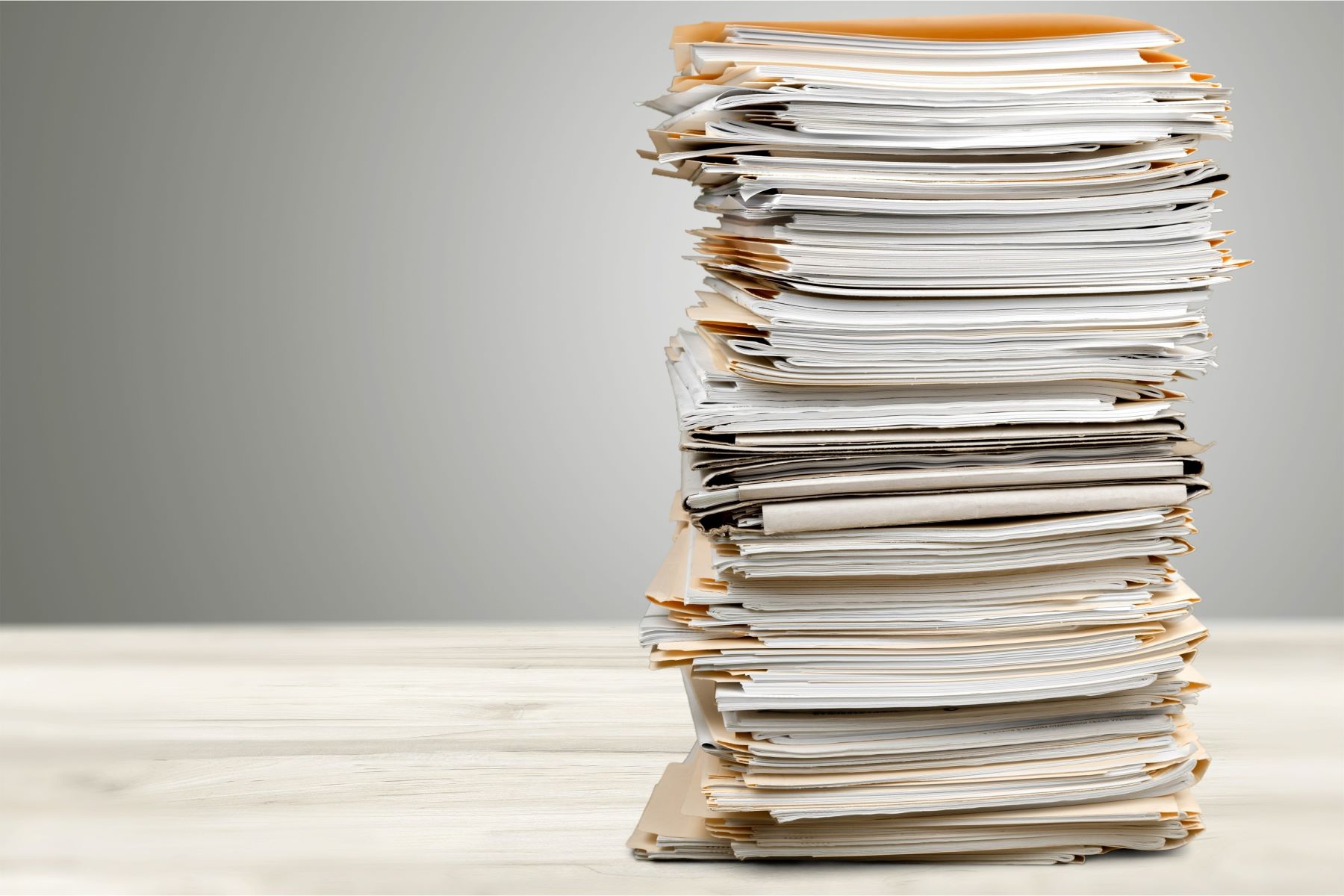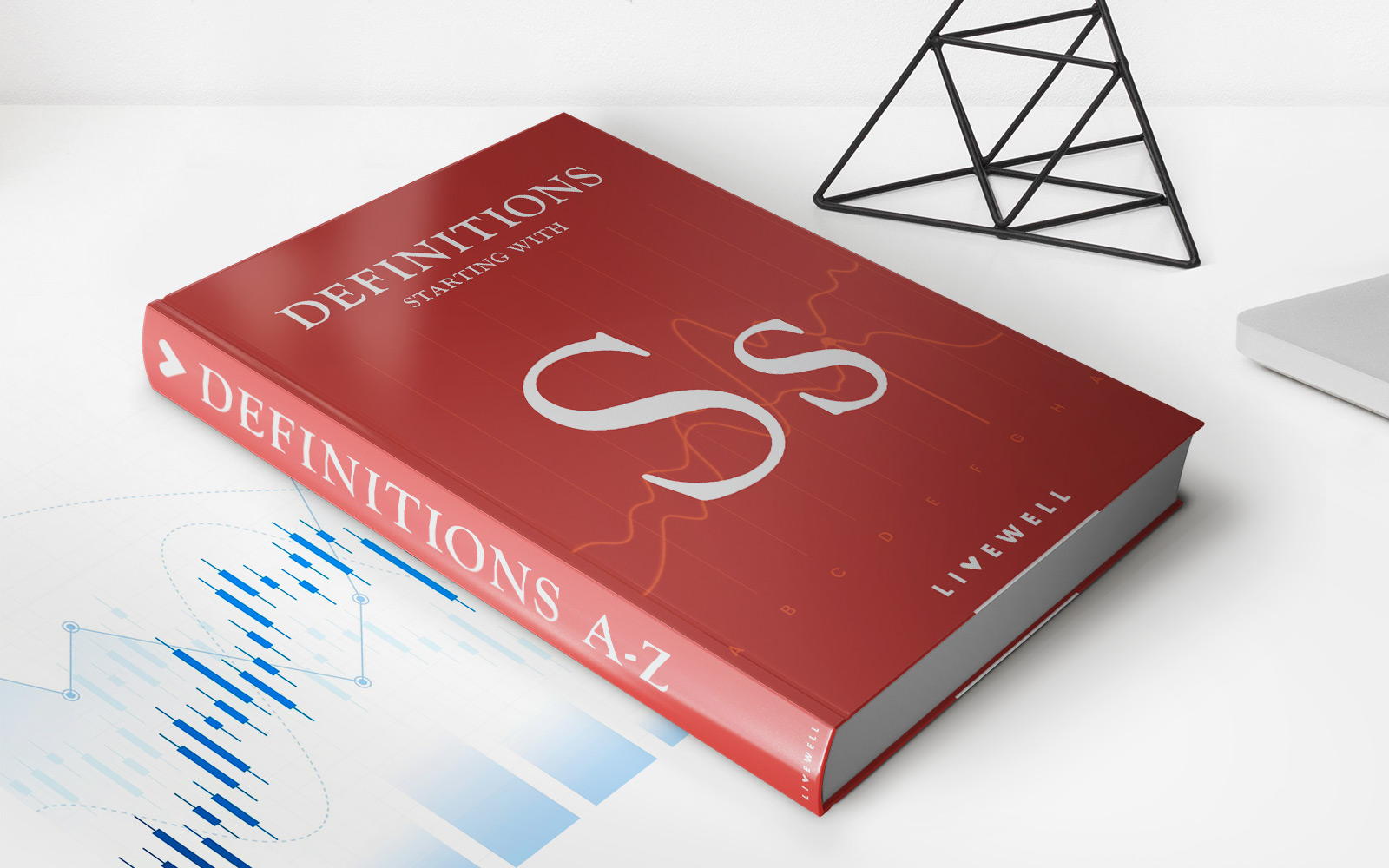

Finance
What Is Source Document In Accounting
Modified: February 21, 2024
Learn what a source document is in accounting and how it relates to finance. Gain a deeper understanding of the role source documents play in financial record-keeping.
(Many of the links in this article redirect to a specific reviewed product. Your purchase of these products through affiliate links helps to generate commission for LiveWell, at no extra cost. Learn more)
Table of Contents
- Introduction
- Definition of Source Document
- Importance of Source Documents in Accounting
- Types of Source Documents
- Sales Invoices
- Purchase Invoices
- Bank Statements
- Receipts
- Payroll Records
- Credit Memos
- Debit Memos
- Vouchers
- Contracts and Agreements
- How Source Documents are Used in Accounting
- Key Information Included in Source Documents
- Retention and Storage of Source Documents
- Conclusion
Introduction
Accounting plays a vital role in managing and tracking the financial transactions of a business. It provides businesses with a clear view of their financial health, allowing them to make informed decisions and comply with legal requirements. One crucial element in the accounting process is the use of source documents.
Source documents are the original records that provide evidence of financial transactions. They are the tangible proof that a transaction has taken place and form the foundation of the accounting process. Without accurate and reliable source documents, it would be nearly impossible to properly record and report financial transactions.
In this article, we will delve into the definition of source documents and explore their significance in accounting. We will also discuss the various types of source documents commonly encountered in financial transactions and how they are utilized in the accounting process.
Understanding source documents is essential for business owners, financial professionals, and anyone involved in the accounting process. By having a comprehensive understanding of these documents, individuals can ensure accurate financial reporting, comply with regulatory requirements, and make informed business decisions.
Definition of Source Document
A source document is an original record that provides evidence of a financial transaction. It is a critical piece of documentation that serves as the starting point for the accounting process. Source documents are created at the time of a transaction and contain important details such as the date, description, amount, and parties involved.
Source documents can take various forms, depending on the nature of the transaction. For example, a sales invoice serves as a source document for a sale transaction, while a bank statement acts as a source document for all the financial activities of a business’s bank account. These documents are used to support the accuracy and reliability of the financial records.
Source documents play a crucial role in ensuring the accuracy and integrity of accounting records. They provide a clear audit trail, allowing financial transactions to be traced back to their original source. This is especially important in case of financial audits, tax compliance, or legal disputes. Source documents provide the necessary proof of the legitimacy and validity of each financial transaction, safeguarding the financial well-being of a business.
It is important to note that source documents must be original and should not be altered or tampered with. Any modifications or additions should be clearly documented with proper explanations. Additionally, source documents should be retained and stored securely for future reference and audit purposes.
Overall, source documents are the foundation of the accounting process, ensuring that the financial transactions of a business are accurately recorded and reported.
Importance of Source Documents in Accounting
Source documents are of utmost importance in the field of accounting. They serve as the primary evidence of financial transactions and play a crucial role in maintaining the accuracy and integrity of accounting records.
Here are some key reasons why source documents are important in accounting:
- Legal Compliance: Source documents are essential for meeting legal and regulatory requirements. They provide the necessary documentation to support the accuracy of financial transactions, ensuring compliance with tax laws, accounting standards, and government regulations.
- Verification and Audit Trail: Source documents enable verification and the creation of a clear audit trail. By providing original records of each transaction, they allow for the tracing of financial transactions from the initial source to the final accounting records. This audit trail is vital for financial audits, internal control assessments, and fraud detection.
- Financial Reporting: Source documents are used to generate accurate and reliable financial statements. They form the basis for recording and summarizing financial transactions, ensuring the completeness and accuracy of the financial information presented in the financial statements.
- Dispute Resolution: In case of any disputes or discrepancies, source documents serve as the supporting evidence. They can be used to resolve disagreements with vendors, customers, or regulatory authorities by providing a clear record of the transaction details.
- Decision-Making: Source documents provide valuable information for making informed business decisions. They offer insights into cash flow, revenue generation, expenses, and other financial metrics, helping business owners and managers analyze the financial health of the company and identify areas for improvement.
- Avoiding Errors and Fraud: Source documents act as a safeguard against errors and fraudulent activities. By accurately documenting each transaction, businesses can detect and prevent errors, identify discrepancies, and deter fraudulent activities.
Overall, source documents are fundamental to the accounting process. They ensure accurate financial reporting, compliance with legal requirements, and provide a reliable record of a business’s financial activities. Any business, regardless of its size or industry, must prioritize the proper documentation and retention of source documents to maintain the integrity and trustworthiness of its financial records.
Types of Source Documents
There are various types of source documents that are commonly encountered in accounting. Each type represents a different financial transaction and serves as evidence of that particular activity. Understanding these different types of source documents is essential for accurately recording and reporting financial transactions. Here are some of the most common types:
- Sales Invoices: Sales invoices are documents issued by a seller to a buyer as evidence of a sale transaction. They include details such as the date of sale, quantity, description, unit price, and total amount. Sales invoices are essential for documenting revenue and accounts receivable.
- Purchase Invoices: Purchase invoices are received by a buyer from a seller to record a purchase transaction. They contain information about the goods or services purchased, including quantities, prices, and payment terms. Purchase invoices are crucial for tracking expenses and accounts payable.
- Bank Statements: Bank statements are official documents issued by a bank that outline all the transactions and the current balance of a bank account. They serve as a source document for recording cash receipts, cash disbursements, and bank charges.
- Receipts: Receipts are written acknowledgments of payment received from customers. They provide evidence of cash or credit card transactions and are crucial for recording revenue and tracking accounts receivable.
- Payroll Records: Payroll records include documents such as timecards, pay stubs, and payroll registers. They document employee compensation, tax withholdings, benefits, and deductions, serving as a source document for payroll expense and liability accounts.
- Credit Memos: Credit memos are issued by a business to a customer when a refund or credit is due. They provide evidence of a reduction in accounts receivable or revenue and serve as a source document for adjusting entries.
- Debit Memos: Debit memos are issued by suppliers when additional charges or adjustments are made to the original purchase. They serve as a source document for adjusting entries to accounts payable.
- Vouchers: Vouchers are internal documents used to authorize and record financial transactions, typically relating to expenses. They provide evidence of the approval, purpose, and amount of the transaction before being recorded in the accounting system.
- Contracts and Agreements: Contracts and agreements are legally binding documents that outline the terms and conditions of a business transaction. They provide evidence of the agreed-upon terms and serve as a source document for recording the related financial transactions.
These are just a few examples of the different types of source documents encountered in accounting. The specific types of documents used will vary depending on the nature of the business and its financial transactions. Regardless of the type, source documents play a crucial role in ensuring accurate and reliable financial recording and reporting.
Sales Invoices
Sales invoices are one of the most common types of source documents used in accounting. They serve as evidence of a sale transaction between a seller and a buyer. When a business sells goods or services to a customer, a sales invoice is issued to document the details of the transaction.
A sales invoice typically includes the following information:
- Date of the sale
- Unique invoice number
- Customer name and contact information
- Description of the goods or services sold
- Quantity of items sold
- Unit price of each item
- Total amount due
- Payment terms and due date
Sales invoices play a vital role in the accounting process for several reasons:
- Revenue Recognition: Sales invoices are the primary source for recognizing revenue. They provide evidence of the sale and the amount that the customer owes to the company.
- Accounts Receivable: Sales invoices are used to track and manage accounts receivable, which represents the outstanding payments from customers. They ensure that all sales are properly recorded and that the amounts owed are accurately reflected in the financial records.
- Tax Compliance: Sales invoices are crucial for tax compliance. They serve as supporting documents for calculating and reporting sales tax, VAT, or other applicable taxes to the relevant tax authorities.
- Audit Trail: Sales invoices provide a clear audit trail of sales transactions. They allow for easy tracing and verification of the revenue recorded in the financial statements back to the original source.
- Customer Communication: Sales invoices also serve as an official communication regarding the transaction details between the seller and the buyer. They provide documentation to both parties and help resolve any disputes or discrepancies.
Properly managing and maintaining sales invoices is critical for accurate financial reporting and effective cash flow management. It is essential to ensure that sales invoices are generated in a timely manner, accurately reflect the terms of the sale, and are properly recorded in the accounting system. By doing so, businesses can maintain proper documentation, strengthen customer relationships, and fulfill their financial reporting obligations.
Purchase Invoices
Purchase invoices are an essential type of source document used in accounting to record the purchase of goods or services from suppliers. When a business buys goods or services, the supplier issues a purchase invoice to document the details of the transaction. Purchase invoices provide evidence of the purchase and serve as the foundation for recording and tracking expenses.
A purchase invoice typically includes the following information:
- Date of the purchase
- Unique invoice number
- Supplier name and contact information
- Description of the goods or services purchased
- Quantity of items purchased
- Unit price of each item
- Total amount payable
- Payment terms and due date
Here are some key reasons why purchase invoices are important in accounting:
- Expense Recording: Purchase invoices are the primary source for recording expenses incurred by a business. They provide evidence of the amount owed to the supplier and ensure that all purchases are accurately recorded in the financial records.
- Accounts Payable: Purchase invoices are used to track and manage accounts payable. They reflect the outstanding amounts owed to suppliers and help businesses stay on top of their payment obligations.
- Financial Reporting: Purchase invoices play a vital role in generating accurate financial statements. They provide the necessary information to properly categorize and report expenses, enabling businesses to analyze their financial performance and make informed decisions.
- Tax Deductions: Purchase invoices are crucial for claiming tax deductions and credits. They serve as supporting documents for deducting business expenses and help businesses ensure compliance with tax laws and regulations.
- Audit Trail: Purchase invoices provide an audit trail for purchased goods or services. They help to verify the expenses recorded in the financial statements by tracing them back to the original source document.
- Supplier Relationships: Purchase invoices serve as official documentation of the purchase agreement between the buyer and the supplier. They facilitate efficient communication and help resolve any discrepancies or issues that may arise in relation to the purchase.
Accurate and timely processing of purchase invoices is crucial for maintaining proper financial records, managing cash flow, and engaging in effective supplier management. Businesses should ensure that purchase invoices are promptly received, matched with purchase orders or receiving documents, and properly recorded in the accounting system. This ensures transparency, reduces the risk of errors, and facilitates smooth financial operations.
Bank Statements
Bank statements are important source documents in accounting that provide a comprehensive record of a business’s financial transactions related to its bank account. They are official documents issued by the bank, typically on a monthly basis, and outline all the inflows and outflows of funds from the account during a specific period.
A bank statement typically includes the following information:
- Account holder’s name and address
- Account number
- Statement period
- Beginning and ending balances
- List of deposits and credits
- List of withdrawals and debits
- Bank fees and charges
- Interest earned (if applicable)
Bank statements are essential for several reasons:
- Reconciliation: Bank statements are used for reconciling a business’s internal records with the bank’s records. By comparing the transactions listed on the bank statement with the corresponding entries in the accounting system, businesses can ensure the accuracy and completeness of their financial records.
- Cash Flow Management: Bank statements provide valuable information about a business’s cash inflows and outflows. They help business owners and managers monitor and manage their cash flow effectively, ensuring that they have sufficient funds to meet their financial obligations.
- Expense Tracking: Bank statements serve as a source document for recording expenses. They provide evidence of payments made to vendors, suppliers, and service providers, allowing businesses to track and categorize their expenses accurately for financial reporting and analysis purposes.
- Interest Calculation: Bank statements also include details of any interest earned on the account balance, which is essential for calculating interest income or expense in the financial statements.
- Bank Reconciliation: In addition to comparing the transactions on the bank statement with the accounting records, bank statements are also used to identify any discrepancies or errors in the bank account. Any discrepancies can be investigated and resolved to ensure the accuracy of the financial records.
- Audit and Compliance: Bank statements serve as supporting documents during financial audits. They provide independent evidence of financial transactions and can be used to substantiate the accuracy and completeness of the financial records.
It is important for businesses to regularly review and reconcile their bank statements to ensure the accuracy of their financial records and detect any unauthorized transactions or errors. This helps maintain the integrity of the accounting system and provides a clear financial picture of the business’s transactions and available funds.
Receipts
Receipts are crucial source documents used in accounting that provide evidence of payment received from customers or clients. They serve as a written acknowledgment of a financial transaction, verifying that a payment has been made for goods sold or services rendered. Receipts play a vital role in recording and tracking revenue, ensuring accurate financial reporting, and maintaining proper documentation.
Receipts typically contain the following information:
- Date of the transaction
- Business name and contact information
- Description of the goods or services provided
- Quantity and price of items sold or services rendered
- Total amount paid
- Payment method
Here are some key reasons why receipts are important in accounting:
- Revenue Tracking: Receipts provide evidence of revenue generated by a business. They validate the amount received and serve as a source document for recording sales and tracking accounts receivable.
- Customer Communication: Receipts serve as official confirmation of payment received, providing customers with a record of their transaction. Receipts are often shared with customers as a proof of purchase, demonstrating good customer service and building trust.
- Audit Trail: Receipts provide an audit trail of payments received, allowing for easy verification and reconciliation with the corresponding entries in the accounting system. They support the accuracy and completeness of the financial records, especially during financial audits.
- Tax Deductions: Receipts are essential for claiming tax deductions and credits. They serve as supporting documentation for business expenses incurred, ensuring compliance with tax laws and regulations.
- Expense Reimbursements: Receipts are necessary for reimbursing employees or contractors for business-related expenses. They serve as evidence of the expense incurred and support the reimbursement process.
- Dispute Resolution: Receipts play a role in resolving disputes or discrepancies. If a customer questions a payment or claims non-receipt of goods or services, the receipt can be used as proof of payment and a point of reference for addressing the issue.
Efficient management of receipts involves ensuring that they are issued promptly, accurately, and stored in a secure and organized manner. Proper recording and retention of receipts contribute to maintaining accurate financial records, complying with regulations, and facilitating effective financial management.
Payroll Records
Payroll records are essential source documents in accounting that document employee compensation and related payroll transactions. They provide evidence of wages, salaries, and deductions, serving as a crucial source of information for recording payroll expenses and liabilities. Payroll records ensure accurate payroll reporting, compliance with labor laws, and the proper management of employee compensation.
Payroll records typically include the following information:
- Employee information such as name, address, and identification number
- Time worked or units produced
- Rate of pay
- Gross wages or salary
- Employee deductions and withholdings (taxes, benefits, retirement contributions, etc.)
- Net pay (amount paid to the employee)
- Pay period dates
Here are some key reasons why payroll records are important in accounting:
- Accurate Expense Tracking: Payroll records serve as source documents for recording and tracking payroll expenses. They ensure that employee compensation is accurately recorded, allowing for precise tracking of labor costs and proper financial reporting.
- Tax Compliance: Payroll records are crucial for complying with tax laws and regulations. They provide the necessary information for calculating and withholding employee income taxes, Social Security, Medicare, and other applicable deductions. Proper documentation of payroll transactions supports accurate and timely tax filings.
- Benefit Administration: Payroll records are used to track employee benefits and deductions such as health insurance premiums, retirement contributions, or flexible spending account allocations. This information is critical for administering and reporting employee benefits accurately.
- Audit Trail and Compliance: Payroll records provide an audit trail for labor-related transactions and ensure compliance with labor laws and regulations. They serve as supporting documentation during financial audits, labor audits, and government agency audits.
- Employee Compensation Management: Payroll records support effective management of employee compensation. They provide historical data on individual employee earnings, hours worked, and deductions, which assists in evaluating performance, analyzing labor costs, and making informed decisions regarding promotions, raises, or incentives.
- Legal Protection: Accurate and well-maintained payroll records provide legal protection for both employers and employees. In case of disputes or legal claims related to wages, hours worked, or employee benefits, payroll records serve as evidence and documentation of payment, deductions, and employee status.
Proper administration and retention of payroll records are crucial for maintaining accurate financial records, complying with regulations, and effectively managing employee compensation. It is essential to ensure that confidential payroll information is securely stored and retained for the required period to meet legal and auditing requirements.
Credit Memos
Credit memos are important source documents used in accounting that provide evidence of a reduction in accounts receivable or revenue. They are issued by a business to a customer when a refund or credit is due, typically due to a return of goods, overpayment, or any other adjustment in the original sales transaction.
A credit memo generally includes the following information:
- Date of the credit memo
- Customer name and contact information
- Description of the reason for the credit
- Amount to be credited
- Reference to the original sales transaction
Here are some key reasons why credit memos are important in accounting:
- Revenue Adjustment: Credit memos reflect a reduction in revenue. They serve as a source document for adjusting the sales revenue and accounts receivable records to accurately reflect the correct amount owed by the customer.
- Customer Service and Satisfaction: Credit memos are issued to customers as a means of resolving any issues or discrepancies in the sales transaction. They demonstrate good customer service and maintain customer satisfaction by promptly addressing concerns and providing appropriate credits or refunds.
- Accounting Accuracy: Credit memos ensure the accuracy of financial records by adjusting revenue and accounts receivable. By properly documenting and processing credit memos, businesses can maintain accurate and reliable financial statements.
- Audit Trail: Credit memos provide an audit trail of adjustments made to accounts receivable or revenue. They support the integrity of the financial records and provide an explanation for any discrepancies or changes that may occur in the sales transaction.
- Financial Reporting: Credit memos play a role in generating accurate financial statements. They ensure that the revenue and accounts receivable balances are reported in line with the adjustment made, providing a true and fair view of the business’s financial position.
Accurate processing and documentation of credit memos are essential for maintaining the integrity of the sales and accounts receivable records. By promptly issuing credit memos, businesses can effectively manage customer relationships, resolve disputes, and ensure the accuracy of their financial reports.
Debit Memos
Debit memos are important source documents used in accounting that provide evidence of an increase in accounts payable or a reduction in expense. They are issued by suppliers or vendors to record additional charges or adjustments made to the original purchase transaction.
A debit memo typically includes the following information:
- Date of the debit memo
- Supplier name and contact information
- Description of the reason for the debit
- Amount to be debited
- Reference to the original purchase transaction
Here are some key reasons why debit memos are important in accounting:
- Expense Adjustment: Debit memos reflect an adjustment to an expense account. They serve as a source document for adjusting accounts payable and expense records to accurately reflect the increased liability or decreased expense.
- Supplier Communication: Debit memos serve as a means of communication between the buyer and the supplier. They notify the buyer of any additional charges, adjustments, or corrections related to the original purchase, ensuring transparency and clear communication between the two parties.
- Accounting Accuracy: Debit memos play a role in maintaining accurate financial records. By properly documenting and processing debit memos, businesses can ensure that accounts payable and expense accounts are correctly stated in the financial statements.
- Audit Trail: Debit memos provide an audit trail of adjustments made to accounts payable or expenses. They support the integrity of the financial records and provide an explanation for any changes or corrections that might occur in the purchase transaction.
- Financial Reporting: Debit memos contribute to accurate financial reporting. They ensure that the appropriate adjustments are made to the accounts payable and expense balances, reflecting the revised financial position of the business.
Proper processing and documentation of debit memos are crucial for maintaining accurate financial records and supplier relationships. By promptly addressing any adjustments or corrections through debit memos, businesses can ensure transparent communication, accurate financial reporting, and effective management of accounts payable.
Vouchers
Vouchers are important source documents used in accounting to authorize and record financial transactions, typically relating to expenses. They provide evidence and documentation of the approval, purpose, and amount of a transaction before it is recorded in the accounting system.
A voucher typically includes the following information:
- Date of the transaction
- Description of the nature and purpose of the expenditure
- Amount to be paid
- Authorized signatures or approvals
- Supporting documentation such as invoices or receipts
Here are some key reasons why vouchers are important in accounting:
- Authorization and Approval: Vouchers provide evidence of the approval process for expenditures. They document the necessary authorizations, ensuring that expenses are approved by the appropriate individuals or departments before payment is made.
- Accounting Accuracy: Vouchers help ensure the accuracy of financial records. By capturing the necessary details and approvals, they provide a record of the transaction that can be relied upon for accurate recording and reporting in the accounting system.
- Expense Tracking: Vouchers play a crucial role in tracking and categorizing expenses. They provide documentation of the purpose of each expenditure, enabling businesses to accurately allocate expenses to the appropriate expense accounts for financial reporting and analysis.
- Audit Trail: Vouchers serve as an audit trail for financial transactions. They provide a record of the authorization and supporting documentation, facilitating the tracing and verification of the transaction from initiation to final recording in the accounting system.
- Compliance and Control: Proper voucher documentation helps ensure compliance with internal controls and regulatory requirements. It establishes a formal process for approving and recording expenditures, reducing the risk of unauthorized or fraudulent transactions.
- Payments and Disbursements: Vouchers are used to initiate payment processes. By providing details of the transactions, they facilitate the timely processing and accurate recording of payments to suppliers, employees, and other beneficiaries.
Effective management of vouchers involves implementing a systematic process for voucher creation, review, approval, and recording. By maintaining well-documented vouchers, businesses can ensure compliance, accuracy, and transparency in their financial transactions and reporting.
Contracts and Agreements
Contracts and agreements are vital source documents used in accounting that establish the terms and conditions of a business transaction. They provide evidence of the agreement between parties involved, and their proper documentation is essential for accurate financial reporting and legal protection.
A contract or agreement typically includes the following information:
- Date of the agreement
- Parties involved and their contact information
- Description of the goods or services to be provided
- Terms and conditions, including pricing and payment terms
- Duration and termination clauses
- Signatures or other forms of approval
Here are some key reasons why contracts and agreements are important in accounting:
- Legal Compliance: Contracts and agreements ensure compliance with legal requirements. They provide clarity on the rights, obligations, and responsibilities of the parties involved and protect all parties from potential disputes or breaches of contract.
- Financial Reporting: Contracts and agreements establish the basis for financial reporting. They define the terms of revenue recognition and expense allocation, ensuring that the financial results of the transaction are accurately recorded and reported in accordance with accounting principles.
- Revenue and Expense Recognition: Contracts and agreements provide guidance on recognizing revenue and expenses associated with the transaction. They determine when revenue should be recognized and how related costs should be allocated, ensuring proper matching of revenue and expenses in the financial statements.
- Payment Obligations: Contracts and agreements specify the payment terms and obligations of the parties. They serve as a source document for billing and collecting payments, ensuring that all financial transactions related to the agreement are properly recorded.
- Legal Protection: Well-documented contracts and agreements provide legal protection for businesses. In case of disputes or disagreements, they serve as evidence of the agreed-upon terms, protecting businesses from potential legal consequences.
- Contract Negotiation and Renewal: Contracts and agreements form the basis for negotiations and renewals. They provide a reference point for discussions on contract terms, pricing adjustments, and potential renewals, facilitating effective contract management.
It is crucial for businesses to establish and maintain thorough documentation of contracts and agreements. They should be properly reviewed, signed, and securely stored, ensuring compliance, accurate financial reporting, and mitigating potential risks or disputes that may arise during the course of the business relationship.
How Source Documents are Used in Accounting
Source documents are key tools used in accounting to record, validate, and document financial transactions. They play a critical role in the overall accounting process, ensuring the accuracy and integrity of the financial records. Here’s how source documents are used in accounting:
Recording Transactions: Source documents serve as the primary evidence of financial transactions. They provide the necessary information to record the transaction in the accounting system, such as the date, amount, description, and parties involved. This information is crucial for accurately reflecting the transaction in the appropriate accounts, ensuring that the financial records are complete and accurate.
Verification and Reconciliation: Source documents are used to verify and reconcile the information in the accounting records. By comparing the source documents to the corresponding entries in the accounting system, businesses can ensure that the transactions have been accurately recorded. This process helps identify any discrepancies or errors, allowing for timely correction and ensuring the integrity of the financial records.
Audit Trail: Source documents provide a clear audit trail of financial transactions. They serve as the basis for tracing and verifying the accuracy of the financial records during internal or external audits. The existence of well-documented source documents strengthens the credibility and reliability of the financial statements and demonstrates compliance with relevant laws and regulations.
Financial Reporting: Source documents are used to generate accurate financial statements. They provide the necessary information to classify and summarize financial transactions, ensuring that revenue, expenses, assets, liabilities, and equity are properly reported. Without reliable source documents, businesses may struggle to produce financial statements that reflect the true financial position and performance of the organization.
Tax Compliance: Source documents are crucial for tax compliance purposes. They support the calculation and reporting of taxes, such as sales tax, income tax, or payroll taxes. Source documents provide the necessary documentation to substantiate the accuracy of the tax filings and help businesses meet their tax obligations in a timely and compliant manner.
Legal Protection and Dispute Resolution: Source documents serve as evidence in legal matters and dispute resolution. In case of disputes or discrepancies, source documents can be used to support claims, resolve conflicts, and protect the rights and interests of the business. Well-documented source documents provide a solid foundation for legal protection and can help mitigate potential risks and liabilities.
Overall, source documents are essential in accounting as they enable the accurate recording, verification, and documentation of financial transactions. They provide the necessary evidence and support for financial reporting, compliance, audits, and legal protection. Businesses must establish robust systems and processes to ensure the proper collection, validation, and retention of source documents to maintain the integrity of their financial records.
Key Information Included in Source Documents
Source documents contain important information that is crucial for accurately recording and documenting financial transactions. The key information included in source documents varies depending on the type of transaction, but here are some common elements:
Date: Source documents indicate the date of the transaction. This information is essential for properly sequencing and organizing financial transactions.
Description: Source documents provide a detailed description of the transaction. They explain the nature of the goods or services exchanged, the purpose of the transaction, or any other relevant details to provide clarity and context.
Amount: Source documents specify the monetary value of the transaction. They include the total amount paid or received, unit prices, quantities, or any other relevant information to accurately reflect the financial impact of the transaction.
Parties Involved: Source documents identify the parties involved in the transaction, such as the buyer, seller, customer, or supplier. This information ensures that transactions are properly attributed to the correct entities in the accounting records.
Payment Terms: Source documents outline the payment terms and conditions agreed upon between the parties. This information can include the due date, payment method, discounts, or any other terms relating to the timing and manner of payment.
References: Source documents often reference other relevant documents, such as purchase orders, sales orders, contracts, or receipts. These references help establish the link between different documents and ensure the accuracy and completeness of the transaction records.
Signatures or Approvals: In some cases, source documents require signatures or approvals from authorized individuals. These signatures or approvals provide evidence of the authorization and validity of the transaction, ensuring proper control and accountability.
Supporting Documentation: Source documents may include supporting documentation, such as invoices, receipts, bank statements, or contracts. These additional documents provide additional evidence and clarification for the transaction, further substantiating its accuracy and legitimacy.
Method of Delivery: For transactions involving the transfer of physical goods, source documents may include information on the method of delivery, shipping details, or tracking numbers. This information helps confirm that the goods have been received or shipped as agreed upon.
Accurate and complete documentation of the key information in source documents is essential for maintaining the integrity of financial records. Businesses should establish proper systems and processes to ensure the collection, validation, and retention of source documents, enabling reliable and accurate recording and reporting of financial transactions.
Retention and Storage of Source Documents
The retention and storage of source documents are crucial aspects of maintaining accurate financial records and complying with legal and regulatory requirements. Source documents should be retained for a specific period of time, depending on the nature of the document and relevant laws. Here are some key considerations for the retention and storage of source documents:
Document Retention Period: The retention period for source documents varies depending on legal and regulatory requirements. It is essential to research and understand the specific requirements for different document types and transactions in your jurisdiction. Common retention periods range from three to seven years, but some documents may need to be retained indefinitely.
Organized Filing System: Implementing an organized filing system is crucial to ensure that source documents are properly stored and easily accessible. Develop a clear and consistent system for labeling, categorizing, and indexing documents, allowing for easy retrieval when needed.
Secure Storage: Source documents should be stored in a secure environment to protect them from loss, damage, or unauthorized access. Consider using fire-resistant cabinets or digital storage solutions with appropriate security measures to safeguard confidential information.
Physical Document Storage: For physical source documents, consider storing them in a dedicated filing room or cabinet. Ensure the area is clean, dry, and free from potential hazards such as water leakage, pests, or excessive sunlight. Label each document clearly for easy identification.
Digital Document Management: Converting physical documents into electronic format can help streamline storage and retrieval processes. Implement a secure digital document management system that includes backup and encryption measures to protect against data loss and unauthorized access.
Backup and Disaster Recovery: Implement regular backup procedures for digital documents to protect against data loss due to technical malfunction, theft, or natural disasters. Maintain off-site backups or utilize cloud-based storage for redundancy and reliable disaster recovery capabilities.
Document Destruction: Once the retention period has expired, dispose of source documents securely and in compliance with data protection and privacy laws. Shred physical documents using a cross-cut shredder, and securely delete digital documents to ensure confidential information cannot be accessed or reconstructed.
Documentation and Audit: Maintain a record of the source documents that have been disposed of, including the date and method of destruction. This documentation can serve as evidence of compliance during audits or in the event of legal inquiries.
Proper retention and storage of source documents are essential for maintaining accurate financial records, complying with legal requirements, and facilitating efficient retrieval during audits or disputes. By implementing sound document management practices, businesses can ensure the integrity, accessibility, and security of their financial records.
Conclusion
Source documents are the backbone of the accounting process, providing evidence and documentation for financial transactions. They play a vital role in maintaining accurate and reliable financial records, ensuring compliance with regulations, and supporting financial reporting and analysis.
In this article, we explored the definition and importance of source documents in accounting. We discussed various types of source documents, including sales invoices, purchase invoices, bank statements, receipts, payroll records, credit memos, debit memos, vouchers, and contracts/agreements. Each type of source document serves a specific purpose in recording, validating, and documenting different financial transactions.
Source documents are used in accounting to record transactions, verify and reconcile financial records, provide an audit trail, generate accurate financial statements, comply with tax regulations, support legal protection, and facilitate dispute resolution. They contain key information such as dates, descriptions, amounts, parties involved, payment terms, references, and supporting documentation.
Proper retention and storage of source documents are essential for maintaining the integrity of financial records. Establishing organized systems, adhering to document retention periods, ensuring secure storage, and implementing backup and disaster recovery procedures are crucial for protecting confidential information and complying with legal requirements.
In conclusion, source documents are the foundation of accurate and complete financial reporting. Businesses should prioritize the collection, validation, and retention of source documents to ensure the integrity of their financial records, support compliance with regulations, and provide reliable information for decision-making.














